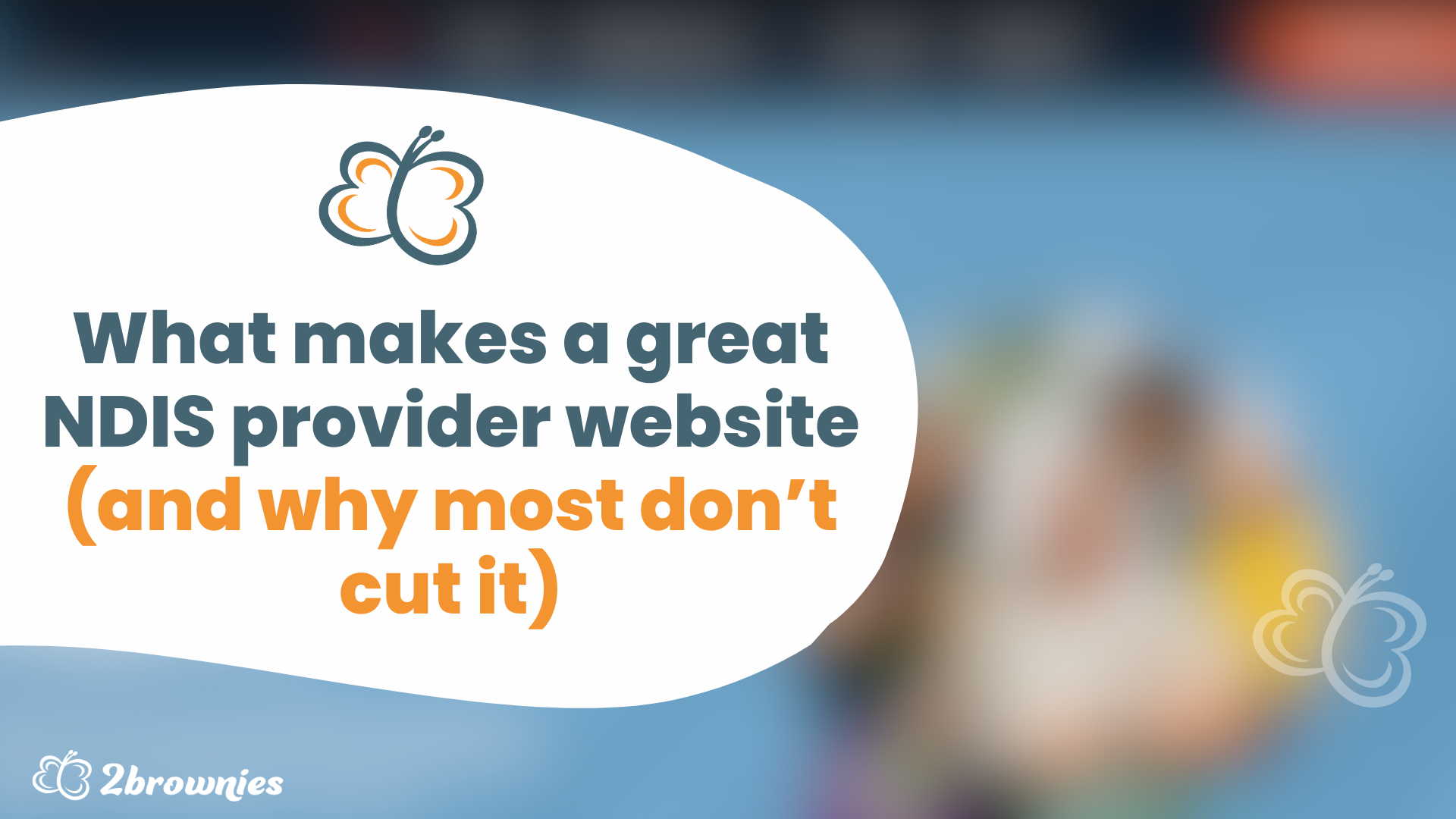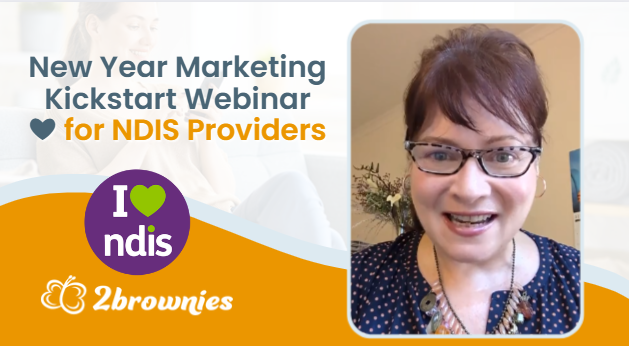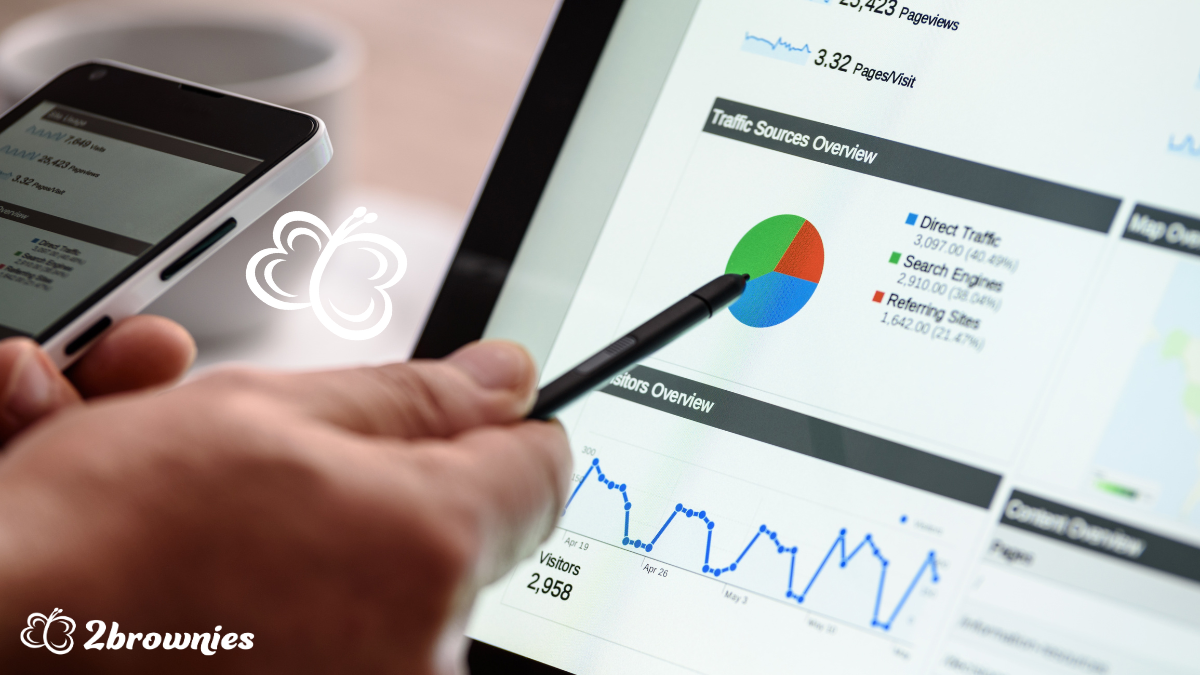
What is Google Analytics? A Guide for Small Businesses
Google Analytics is a free web analytics service offered by Google that allows you to track and analyse data about your website's visitors. By leveraging the insights provided by Google Analytics, businesses can make informed decisions on how to improve their online presence and better cater to their target audience.
In this blog post, we'll explore the numerous benefits of using Google Analytics for your small business, such as identifying trends and valuable insights from user behavior. We'll also investigate how to configure a Google Analytics account and connect it with other programs like Adsense and Search Console for maximum productivity.
We'll also delve into the various reporting features available within the platform - including audience reports, funnel visualisation report, site search analysis - which enable you to collect data from multiple sources effectively. Finally, learn how to analyse your data with advanced techniques such as machine learning integration for more accurate results.

Table of Contents
- Table of Contents:
- A Brief Overview of Google Analytics
- Analysing Data Through Reports
- Benefits of Using Google Analytics
- A. Understand Your Website Traffic
- B. Measure Marketing Efforts
- C. Improve User Experience (UX)
- D. Identify Top Performing Content
- E. Set Goals and Track Conversions
- Setting Up Google Analytics
- Create a Google Analytics Account
- Add Tracking Code To Your Website
- Configure Additional Settings (Optional)
- Create Goals
- Set Up Filters
- How to Use Google Analytics
- Navigating the Dashboard
- Setting Goals
- Analysing Traffic Sources & Channels
- Monitoring User Behavior & Engagement
- Analysing Your Data with Google Analytics
- Audience Overview Report
- Traffic Acquisition Report
- Behavior Flow Report
- Conclusion
Google Analytics is a powerful and comprehensive web analytics platform that helps Australian small businesses with a website to gain valuable insights into their website traffic and user behavior. By tracking various metrics such as page views, bounce rate, conversion rates, and more, Google Analytics enables you to understand how your visitors interact with your site and make data-driven decisions for improvement.
A Brief Overview of Google Analytics
Google Analytics was launched by the search engine giant back in 2005 after acquiring Urchin Software Corporation. Since its launch, Google Analytics has become a must-have for millions of websites around the world due to its comprehensive features and simple setup.
The platform's main purpose is to acquire data regarding your website through the use of JavaScript code snippets inserted on each page. This allows you to track numerous aspects such as:
- User demographics (age, gender)
- Traffic sources (organic search results or referral links)
- User behavior (pages visited or time spent on site)
- E-commerce transactions (if applicable)
Analysing Data Through Reports
Once the data has been collected by Google Analytics from your website's activity, it can be analysed through various reports available within the platform. These reports are divided into five main categories:
- Real-Time: Provides live information about active users currently browsing your site.
- Audience: Offers detailed demographic information about who visits your site.
- Acquisition: Shows how users found your site, whether through search engines or other sources.
- Behavior: Reveals how visitors interact with your website's content and functionality.
- Conversions: Tracks the success of specific goals you've set up for user actions on your site (e.g., form submissions or purchases).
By leveraging conversion data to make effective changes, you can maximise your website's potential and create a positive user experience that leads to increased traffic, higher conversion rates, and improved overall performance.
Now let's look at some of the benefits of using Google Analytics in more detail.
Benefits of Using Google Analytics
As a small business owner with limited time, you might be wondering why you should both using Google Analytics for your website. The truth is that this powerful tool offers numerous benefits that can help you grow your online presence and ultimately drive more sales. Let's dive into some of the key advantages:
A. Understand Your Website Traffic
Google Analytics provides detailed information about the number of visitors coming to your site, their geographical location, devices used to access the site, and much more. By leveraging the data provided by Google Analytics, you can gain insight into your target audience and adjust your website content to better suit their needs.
B. Measure Marketing Efforts
If you're investing in marketing campaigns such as social media advertising or email newsletters, it's crucial to know if these efforts are driving results. With Google Analytics' campaign tracking features, you can measure the effectiveness of various marketing strategies by analysing traffic sources and conversions.
C. Improve User Experience (UX)
The user experience on a website plays an essential role in retaining customers and encouraging them to make purchases or engage with content further. By examining metrics like bounce rate, average session duration, and pages per session provided by Google Analytics, you can identify areas where users may be facing difficulties navigating through the site or finding relevant information. By addressing these issues, you'll create a better UX which will lead to higher customer satisfaction rates.
D. Identify Top Performing Content
Your website likely contains multiple pages covering different topics related to your business. Google Analytics helps you identify which pages are resonating most with visitors by analysing metrics like page views, time on page, and conversion rates. This information allows you to focus on creating more content that appeals to your audience and drives results.
E. Set Goals and Track Conversions
Every small business has specific objectives they want their website visitors to complete, such as making a purchase or filling out a contact form. Google Analytics' goal tracking feature enables you to set up these sorts of goals within the platform so that you can monitor how often users complete them. By understanding what's working (and what isn't), you can make decisions based on data regarding where improvements need to be made.
Incorporating Google Analytics into your website design strategy is essential for any small Australian business looking to grow its online presence effectively.
Setting Up Google Analytics
To get started with Google Analytics, you need to set up a new account and integrate it into your site. Or you can leave it all to 2Brownies as part of our Kick-Start SEO package. If you're keen to set-up your own account and integrate it with your website, read on.
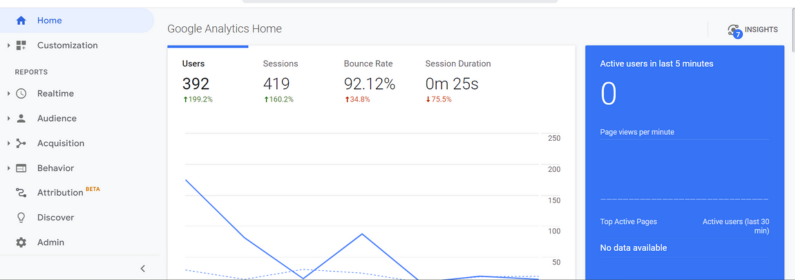
Create a Google Analytics Account
- Navigate to the Google Analytics homepage and sign in using your existing Google account or create a new one if necessary.
- Click on "Start measuring" to begin setting up your analytics account.
- Enter an appropriate name for the account (e.g., Your Business Name) and configure any additional settings as needed before clicking "Next."
- Select what you want to measure: Web, Apps, or both depending on where you want data from. For most small businesses selecting 'Web' will suffice.
- Add details about the property (your website), including its name and URL, then click "Create."
Add Tracking Code To Your Website
To enable data collection by Google Analytics, insert the provided tracking code snippet into every page of your site that you wish to monitor. This can be done manually or through various plugins available for popular content management systems such as WordPress:
- Manual insertion:
- Copy the Global Site Tag (gtag.js) generated during setup.
- Paste it directly after the opening <head> tag on each page of your site.
- WordPress:
- Install a plugin like GA Google Analytics or MonsterInsights.
- Follow the plugin's instructions to connect it with your Google Analytics account and insert the tracking code automatically.
Configure Additional Settings (Optional)
You may want to customise some settings within Google Analytics, such as creating goals for specific user actions or setting up filters to exclude internal traffic. These are optional but can provide more accurate data and help you focus on key performance indicators relevant to your business.
Create Goals
To track specific objectives, follow these steps:
- In the Admin panel of your Google Analytics account, click "Goals."
- Select "+ New Goal," then choose from pre-set templates or create custom goals based on events, pages visited, duration spent on-site, etc.
- Name the goal and configure its details before clicking "Save."
Set Up Filters
To exclude certain types of traffic from being tracked in analytics reports:
- Navigate to 'Admin' > 'Filters' under 'View.'
- Create new filters for IP addresses you wish not to be included in data collection (e.g., company offices).
With everything set up correctly, you'll soon start seeing valuable data pouring into your Google Analytics account. The next step is learning how to use this information effectively.
How to Use Google Analytics
Having set up your Google Analytics account, it's now time to explore the features and tools offered. This section will provide an overview of how to use Google Analytics effectively for your small business.
Navigating the Dashboard
Familiarise yourself with the layout of Google Analytics' dashboard and its distinct sections, e.g., Real-time, Audience, Acquisition, Behavior & Conversions.
Setting Goals
To measure the success of your website design or marketing efforts accurately, it's essential to set up goals in Google Analytics. Goals can track specific actions users take on your site (e.g., making a purchase or signing up for a newsletter), allowing you to see which strategies are most effective at driving conversions.
- Create custom goals based on user engagement metrics like pages per session or average session duration.
- Use predefined templates provided by Google Analytics for common goal types such as destination URL visits or event completions.
- Evaluate goal performance regularly using conversion rate data found within the "Conversions" section of the dashboard.
Analysing Traffic Sources & Channels
Understanding where your website traffic comes from, whether through organic search results or paid advertising, is crucial for optimising your marketing efforts. Google Analytics provides detailed information on traffic sources and channels in the "Acquisition" section of the dashboard.
- Monitor organic search performance to identify high-performing keywords or content topics that attract visitors.
- Analyse referral traffic from other websites to discover potential partnership opportunities or popular backlinks driving users to your site.
- Evaluate paid advertising campaigns by tracking clicks, impressions, and conversions through Google Ads integration with Google Analytics.
Monitoring User Behavior & Engagement
By analysing user behavior data, you can gain insight into how users interact with your website's content and make informed decisions to improve or redesign pages for better engagement. Some key metrics to monitor include:
- Bounce Rate: The percentage of single-page sessions where a user leaves without interacting further with your site. A high bounce rate may indicate poor-quality content or ineffective calls-to-action (CTAs).
- Average Session Duration: The average time spent by users on your website during a session. Longer durations typically suggest more engaging content that keeps visitors interested.
- Pages per Session: The average number of pages viewed during a single session. Higher values indicate greater user engagement across multiple areas of your site.
In addition, don't forget to explore advanced features such as creating custom segments, setting up event tracking, and utilising attribution models within Google Analytics. These tools can provide even deeper insights into specific aspects of your website's performance and help guide future optimisation efforts.
If all this is sounding too technical, you can always leave the implementation, tracking and optimisation to 2Brownies as your digital partner.
Analysing Your Data with Google Analytics
Now that you've set up and started using Google Analytics, it's time to dive into the data and make informed decisions about your website's performance. In this section, we'll discuss how to interpret the data collected by Google Analytics and use it to improve your online presence.
Audience Overview Report
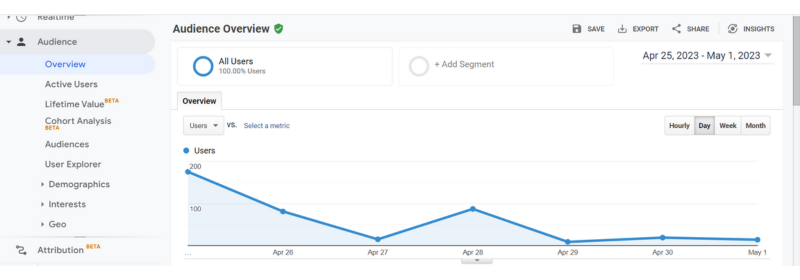
The Audience Overview report is a great starting point for understanding who visits your site. This report provides insights into user demographics, location, language preferences, devices used, and more. By analysing this information, you can better tailor your content strategy to suit the needs of your target audience.
- User Demographics: Identify age groups and gender distribution among visitors.
- Location: Determine where most of your traffic comes from geographically.
- Language Preferences: Understand which languages are preferred by users visiting your site.
- Browsers & Devices: Learn what types of devices (desktop / mobile / tablet) users access your site on as well as their browser preferences.
Traffic Acquisition Report
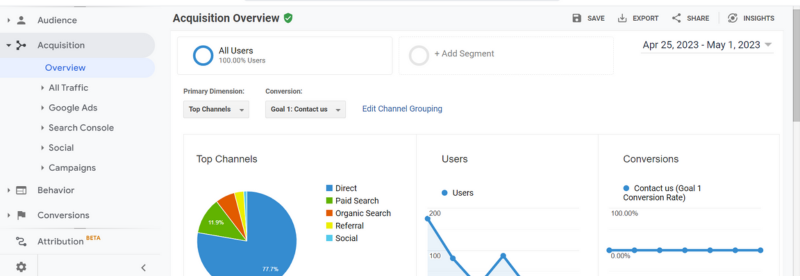
The Traffic Acquisition report helps identify how users find their way to your website. It breaks down incoming traffic sources such as organic search results (e.g., through Google Search or Bing), direct links (users typing in URLs directly), referral links from other websites, and social media platforms like Facebook or Twitter. Understanding these channels will help you optimise marketing efforts accordingly.
- Organic Search: See which search engines are driving the most traffic to your site and identify popular keywords.
- Direct Traffic: Determine how many users are directly typing in your website's URL or accessing it through bookmarks.
- Referral Traffic: Identify websites that link to yours, driving visitors from their pages to yours.
- Social Media Traffic: Measure the effectiveness of social media campaigns by tracking visits from platforms like Facebook, Twitter, LinkedIn, etc.
Behavior Flow Report
The Behavior Flow report helps you understand how users navigate through your website. This report displays the path taken by visitors as they move between different pages on your site. Analysing this information allows you to detect possible roadblocks and make modifications to the user experience accordingly.
- Landing Pages: Discover which pages users first arrive at when visiting your site.
- Drops-offs & Exits: Identify where users tend to leave or abandon their journey on your website - a high exit rate may indicate issues with content or usability.
- User Pathways: Analyse common paths taken by visitors throughout their time on-site; use this information to optimise navigation and streamline user journeys.
Analysing Google Analytics data is crucial for making informed decisions about improving both marketing efforts and overall user experience. Examining the data regularly can enable you to discover trends and habits that will allow your marketing decisions to be driven by facts.
With the recent release of Google Analytics 4, Google now uses machine learning to provide even more valuable insights. It offers new reporting features such as user-centric analysis and predictive metrics.
At 2Brownies, we understand the importance of web analytics and offer Google Analytics integration services to our clients. Contact us today to learn more about how we can help you get the most out of Google Analytics.
Conclusion
The Benefits of Using Google Analytics
- Understand your audience better
- Track the effectiveness of your marketing campaigns
- Identify areas for improvement on your website
By adding a tracking code to your website, you can monitor how users interact with your site and gain insights into their behavior. Additionally, Google Analytics can also be used to track mobile app usage, making it a versatile tool for businesses with both a website and mobile app presence. At 2Brownies, we highly recommend using Google Analytics to gain a better understanding of your audience and improve your marketing strategies.
Are you a small business looking to build your reputation and make your mark? We create awesome websites, social media content, blog posts, SEO and Google Business profiles for small businesses across Australia. Call us on
1300 608 114 or book a chat here:
https://calendly.com/2brownies/chat. Our General Manager Vanessa would be happy to answer your questions.

About the Author
Our General Manager, Vanessa, has a background as a business consultant and loves to share her experience and perspective with our clients and readers. If you have questions about your own NDIS provider business, chat with Ness anytime on 1300 608 114 or
find Ness on LinkedIn
or follow Ness for NDIS Provider insights on Medium.
Learn more about Vanessa
here.

